(Last updated on January 9th, 2023)
Solidworks or Fusion 360, which software is a better choice in 2023? Or is there a clear winner between the two?
Read this ultimate Solidworks vs. Fusion 360 comparison to get all the answers.
In this article, we will clarify the difference between Solidworks and Fusion 360. Solidworks was initially designed by Solidworks Corporation and was later purchased by Dassault Systems.
Fusion 360 was released by Autodesk in 2012, first in September as Simulation 360, and then in November as Fusion 360; the “CAD in the cloud.” Both applications are very similar in many ways while very different in others.
While I was initially studying these to applications, I found myself scratching my head and confused as to why Autodesk offers Fusion 360 when it is so similar in function to Autodesk Inventor. Then, I saw this (see image below):
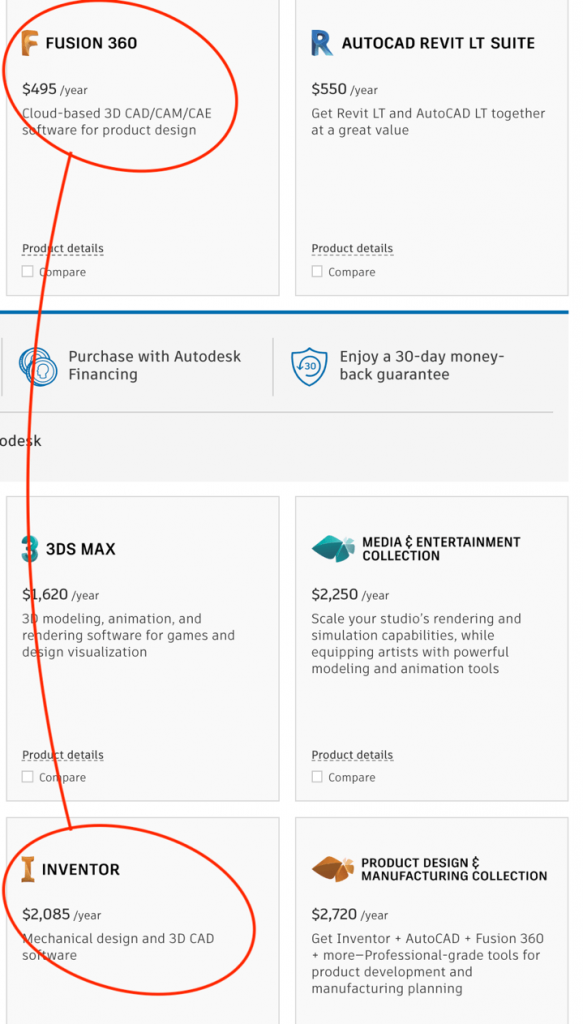
Når det kommer til design og konstruksjon av https://toppcasinonorge.com/yaacasino/ kasino, er SolidWorks og Fusion 360 programvare blant de mest populære valgene. Det er fordi disse programmene tilbyr et bredt spekter av funksjoner og muligheter som gjør dem ideelle for å lage alt fra det første oppsettet til de detaljerte tegningene. Noen av de viktigste fordelene med å bruke SolidWorks og Fusion 360 inkluderer muligheten til å lage fotorealistiske bilder, generere realistiske simuleringer og lage animasjoner. Dette gjør at casinodesignere kan få en god følelse av hvordan det ferdige produktet vil se ut og føles. I tillegg gjør disse programmene det enkelt å oppdage potensielle problemer og rette dem før byggingen i det hele tatt begynner.
Suddenly it all made sense! Fusion 360 is like “Diet Solidworks” (or Diet Inventor). It is a legitimate CAD/CAM 3D modeling application that can “hang in there” with Solidworks (or Inventor). Still, Fusion 360 is entirely outshined by Solidworks when scrutinized one category at a time.
There is a niche market for those who need some kind of basic CAD/CAM modeling program, but don’t need all the bells and whistles. The people in this niche market can “get by” with Fusion 360, and they are much happier with the price. In contrast, Solidworks is more powerful, more feature-rich, more customizable, and more complex. It dominates the market, but not everyone needs all that power.
I read a few articles on how Fusion 360 was released as Autodesk’s answer to the demand for “CAD in the cloud.” As I looked more into this claim, it seems that while it was an exciting thing back in 2012, Autodesk’s product pages don’t make much mention of how Fusion 360 is “a cloud-based solution.”
As I’ve researched Solidworks and Inventor (Our Review on these two), they both seem to have collaboration tools. So maybe between 2012 and 2020, the “cloud-ness” of Fusion 360 became less critical. Although, there’s another aspect of Fusion 360 that heavily relies on the cloud. We will go over that in more detail later in the article.
What people seem to like about Fusion 360 these days is that it is a cool middle-ground between Sketchup and Solidworks. The modeling tools are more straightforward than Solidworks, albeit less versatile, but it still has enough capability to model anything. It also has enough simulation and CAD/CAM tools to make it a viable platform for manufacturers.
Short Verdict
I’m judging this comparison based on this standard; “Which of these two programs is the most powerful and capable tool for product development and manufacturing?” Solidworks is the winner based on this standard, and there’s no doubt about that.
After playing around with Fusion 360 for a while, there’s just no comparison. Fusion 360 is stripped down to the bare minimum of functionality, while Solidworks is the cutting edge of what is possible. Can you “get by” with 360? I suppose so, depending upon your needs.
Get up to 70% Off on Top Products!

Autodesk
See the latest Autodesk deals, discounts, promotions, and bundled packages. Save up to 70% on top products!
at autodesk.com

Fusion 360
Fusion 360 is a cloud-based CAD/CAM/CAE software for product design.
at autodesk.com

Inventor
Inventor offers industry-standard product design and engineering tools for 3D mechanical design, visualization, simulation, and documentation.
at autodesk.com
Still, if you’re looking for the best available design capability, Fusion 360 just isn’t the heaviest hitter in the marketplace.
| Criterion | Fusion 360 | Solidworks | Notes |
| Price | Winner | N/A | Solidworks requires the purchase of a license between $4000 – $8000, plus ~$1500 per year for the maintenance subscription (if you want the latest version). Fusion 360 is just $450/year plus whatever you spend on “Cloud Coins.” What are Cloud Coins? See below under the “price” section. |
| UI | Winner | N/A | Fusion 360 is simpler than Solidworks, but still a powerful software in its own right. |
| Learning Curve | Winner | N/A | Fusion 360 is easier to learn and grasp. |
| Capabilities | N/A | Winner | While Fusion 360 can do almost everything that Solidworks can do, at the end of the day, Solidworks is much more powerful all around. Fusion 360 can’t make electrical connections at all, while Solidworks is an industry leader in all aspects of product design, including wiring. |
| Parts Library | N/A | Winner | Many people consider this Fusion 360’s biggest shortcoming. Perhaps in years to come, Autodesk will realize this and improve upon this aspect, but for now, Solidworks takes the cake in this category. |
| Materials | N/A | Winner | This one is pretty close, actually, but still, Solidworks can do just a little bit more than Fusion 360. |
| Rendering | N/A | Winner | Again, pretty close, but Solidworks is better in many ways. |
| Simulation | N/A | Winner | Solidworks is not only more capable in this category, but it needs to be emphasized; Fusion 360 requires Cloud Coins to utilize this function. |
| Electronics | N/A | Winner | Fusion 360 can make wires, but they don’t have actual properties. Whereas Solidworks has a dedicated electrical wiring library of standard parts to pull from. |
In-Depth considerations
1. Price
| Product | Regular Price | Discounted Price |
| Fusion 360 | $495/year | Check here |
| SolidWorks | $3995 license + $1295/year | No Discount |
| Autodesk Deals & Packages | varies | Check here |
Winner: Fusion 360
- Free Trail – Both Dassault Systems and Autodesk offer 30-day trails for their software.
- Student/Educator Editions – Solidworks offers a student license for $150/year. Fusion 360 is available for free; you just need to renew the license once every three years.
- Standard, Professional, & Premium – Solidworks comes in “Standard,” “Professional,” and “Premium” categories. Licenses cost between $4000 and $8000. Fusion 360 is only available via monthly, annual, or Tri-annual subscriptions, and costs $495/year.
- Subscriptions – Fusion 360 is available for $495/year, including annual software upgrades. When you purchase the license for Solidworks, you effectively own that year’s version, but if you want the latest year-by-year version, you have to pay an annual maintenance subscription. It costs about $1500 or more, depending upon which version you have.
- Cloud Credits – What are “Cloud Credits,” you ask? Well, they are tokens that need to be purchased to gain single-use access to Fusion 360’s more advanced tools such as simulation, rendering, etc. 1 Cloud Credit = 1 USD.

2. UI
Winner: Fusion 360
This one took me a little thought, and I switched my verdict after more consideration. At first, I was inclined to give this one to Solidworks simply because Solidworks has more capabilities.
When I first saw the Fusion 360 UI, I thought, “Are you kidding me?” There seemed to be a few buttons and so few options that I thought there was no way it could do all the advertisements said it could. But after watching a few tutorial videos, I started to see that looks can be deceiving. All the options and capabilities in Fusion 360 are just organized in a way that gives it a straightforward and unintimidating look.
(Left; Fusion 360 UI. Right; Solidworks UI)

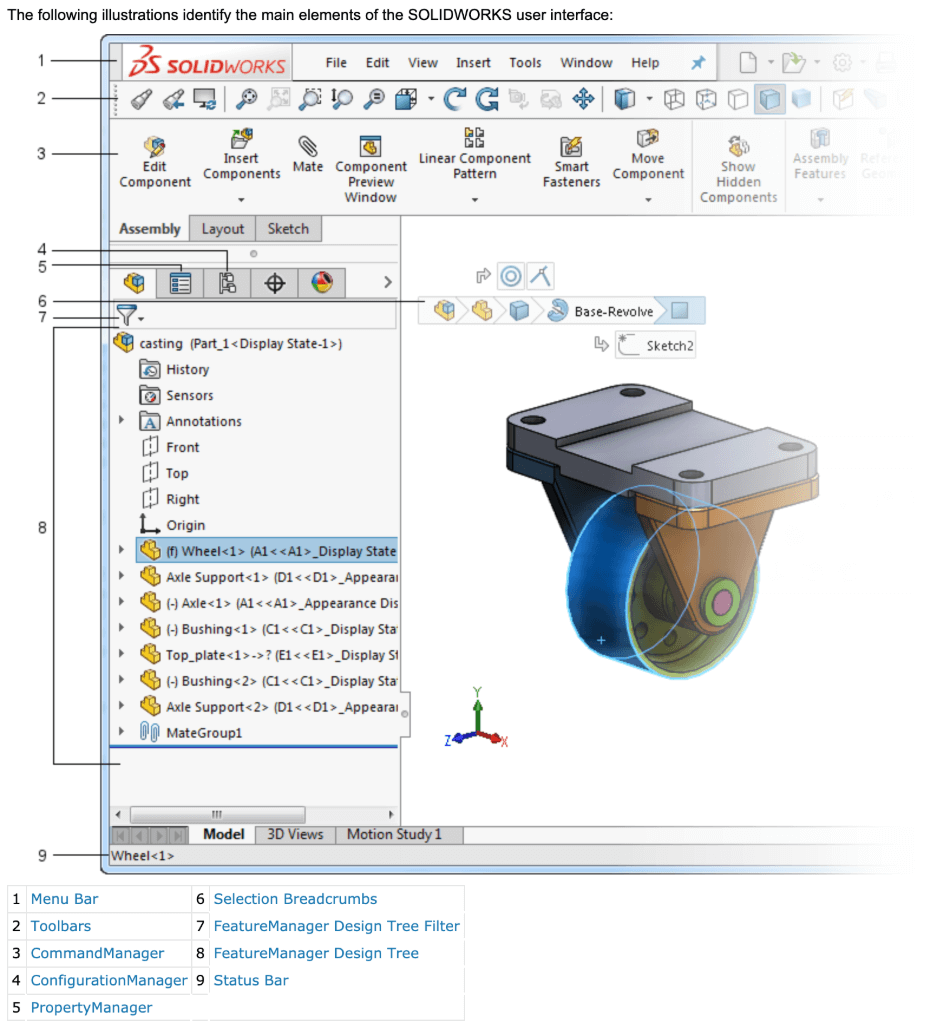
3. Learning Curve
Winner: Fusion 360
While Solidworks has more customizability and capabilities than Fusion 360, Fusion 360 is much simpler; therefore, the learning curve is not as steep. With proper training, however, you can master the power of Solidworks.
4. Capabilities
Winner: Solidworks
Generally speaking, Solidworks and Fusion 360 have pretty much the same capacities and capabilities. However, Solidworks is more advanced at each one of them.
Both applications can access a parts library for standard parts such as screws, bolts, etc., both can simulate stresses. But Solidworks can do far more complex simulations. Both can apply material qualities to the forms you model, but Solidworks is more customizable. Both can render your models and materials to show what the actual product might look like, but Solidworks is more powerful. On principle, Solidworks is just beefier all around.
5. Parts Library
Winner: Solidworks
I was looking into this topic, and there tends to be a consensus among people that Fusion 360’s library of parts is inferior to that of Solidworks (or even Inventor). So much so, that people were saying they felt this was Fusion 360’s “only real problem,” in their opinion.
When modeling something that is going to be manufactured, it is critical for your invention to be compatible with a lot of standard bolts, screws, parts, electronics, holes, etc. A ready selection of these parts is considered by many to be a necessary component of their CAD/CAM application.
The literature I was reading on this topic was a couple of years old, so maybe Autodesk has put some effort into improving this. As such, I recommend you consider the importance of a parts library for your personal needs.
6. Materials
Winner: Solidworks
From what I can tell, Solidworks is still the winner of this category due to the broader range of materials that you can apply to your modeled parts. You can fully customize a material with all its physical attributes. You also have a library of standard materials at your disposal to run your simulations.
Fusion 360 can do the same operations and has a decent amount of customizability. You can do stress tests and weight reduction simulations on both Solidworks and Fusion 360.
7. Rendering
Winner: Solidworks
You should be noticing a pattern here, by now. Again, I am saying Solidworks is the winner for yet another category simply because it’s more verstile and capable.
As with previous categories, Fusion 360 can keep up pretty well and produce photorealistic renderings with lots of options. Still, Solidworks offers more advanced capabilities for these renderings.
I watched a few examples of experienced pros utilizing both Fusion 360 and Solidworks, and, honestly, Fusion 360 holds its own.
(Top; Fusion 360 photorealistic rendering. Bottom; Solidworks photorealistic rendering)
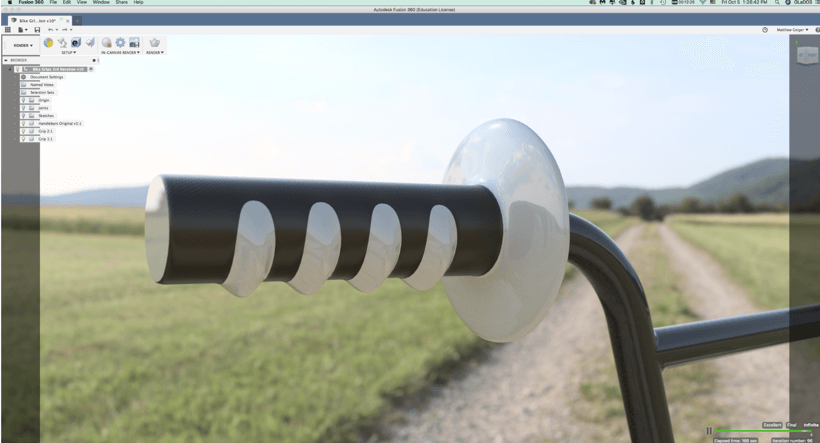
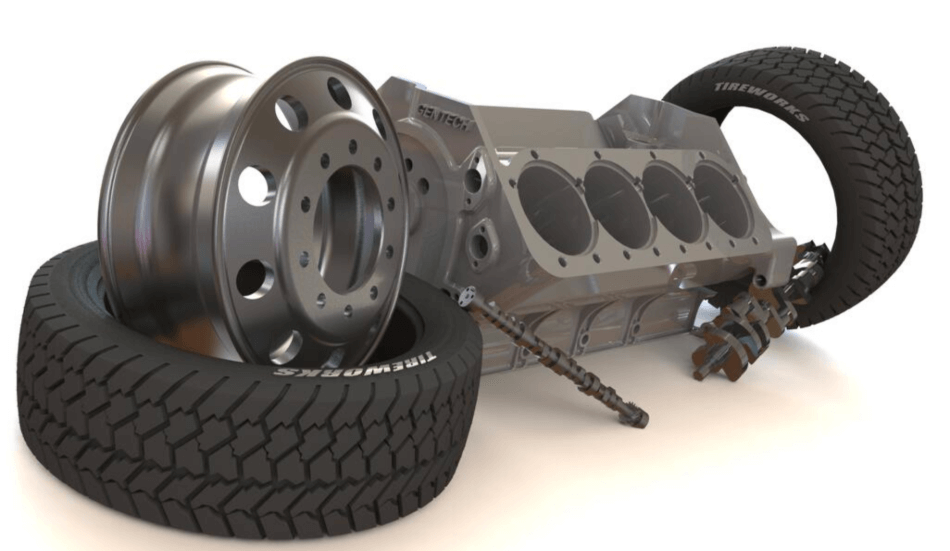
8. Simulations
Winner: Solidworks
Sticking to the same pattern here, Fusion 360 and Solidworks are both capable of running simulations. So it’s here where I must talk about the “cloud coins.” Some of Fusion 360’s capabilities are available only via cloud credits. Most of Fusion 360’s more advanced functions require cloud credits.
That being said, scroll down below to check out the “CAD in the Cloud” section. I’ll run down a few details about the cloud credit services and their costs.
9. Electronics
Winner: Solidworks (This is a definitive win for Solidworks)
For a real electronic invention to work, they need to be wired with electricity and circuit boards. Believe it or not, Solidworks can do that. What CAN’T Solidworks do? I guess the only better thing would be to reach into your monitor and pull out the invention.
Hopefully, that won’t happen anytime in the near future, because I wouldn’t be able to handle it. I would literally have a brain aneurysm. Fusion 360 can draw in wires, but as far as my research has found, Fusion 360 cannot simulate wiring, nor can it pull industry-standard wires and connectors from its library.
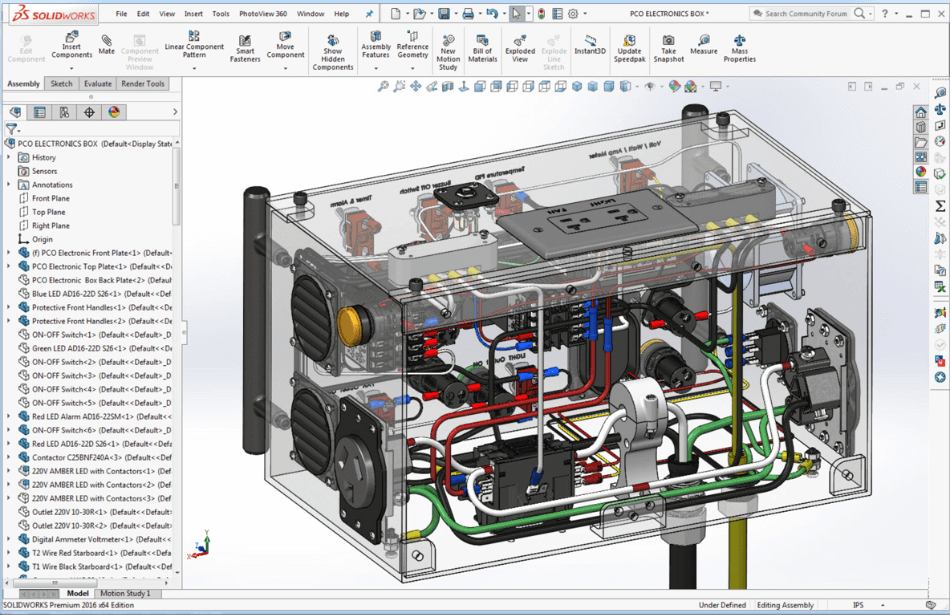
CAD in the Cloud
The most significant difference between Solidworks and Fusion 360 is that Fusion is a cloud-based application. A lot of the rendering and simulating power can be performed on Autodesk’s servers versus utilizing your hardware.
This cloud rendering makes Fusion 360 great for people who don’t have a big beefy computer, but it does mean you have to rely upon your internet connection. The cloud has its advantages, but also its drawbacks. The biggest of these drawbacks is the additional cost of the cloud services.
Now, let’s face it, the price for a Solidworks License is BIG compared to the subscription for Fusion 360, so you can buy a lot of Cloud Credits before you even match the cost of Solidworks, but it’s still a bummer to have to fork out the extra dough for something every time you want to use it. Here’s a shortlist of the prices of for different cloud services:
USD 1 = 1 Autodesk Cloud Credit
Rendering = 1+ credits per render (depending on how complex the model you’re rendering)
Running Simulation = 5 credits ea.
Structural Buckling Simulation = 15 credits ea.
Nonlinear Static Stress Simulation = 25 credits ea.
Other advanced services are pay-as-you-go, so this is just a shortlist to give you an idea.
Fusion 360 Summary
Fusion 360 is an intriguing product when you think about it. It is offered by the same company that produces other heavy-hitting 3D applications such as Inventor, Maya, and 3DS Max, etc. It has so many fully-functioning advanced capabilities that are comparable to Solidworks, yet the price for utilizing this application is dramatically less than Solidworks.
On the other hand, the more advanced tools for generative design, simulation, rendering, etc. are all cloud-based services. So you might find yourself spending a lot of money on these Cloud Credit services as the years pass. Fusion 360 is also easy to collaborate with other teams because it is cloud-based.
Furthermore, Fusion 360 has a dramatically more straightforward UI and is much more user-friendly than Solidworks. This simple UI brings 3D product design into the hands of those who aren’t ready to take on the Solidworks learning curve. As a result of which, Fusion 360 still has me scratching my head.
When I think about it one way, it makes sense to start with Fusion 360 and, maybe, later down the road, switch to Solidworks. Still, when I think about it another way, it might be better to wrap your arms around Solidworks and gain the full freedom to utilize its rendering, simulating, wiring, etc. capabilities without worrying about the Cloud Credits.
Solidworks Summary
Solidworks is, just as its namesake suggests, solid! There’s nothing it can’t do, and while Fusion 360 can compete and hold its own in the CAD/CAM marketplace, Solidworks ultimately shuts down Fusion 360 in every department. If your organization is bent on creating a superior product and utilizing the best tool at its disposal, then bite the bullet and go with Solidworks.
If you are a more independent designer and want to grasp the basics of 3D CAD/CAM and product manufacturing, Fusion 360 will be like a pricy set of training wheels. You can expect Solidworks to remain on the cutting edge, possibly leaving Fusion 360 in the dust when it comes to its army of features.
Additional Thoughts
The Verdict for 3D Design Newbies
If you are trying to get your feet wet in the 3D modeling and product design world, I would strongly recommend Fusion 360. Once you get a few projects under your belt using this program, you will have a strong foundation that will enable you to easily branch into Solidworks (or Inventor, which is Autodesk’s analog of Solidworks).
At the very least, Fusion 360 will be like a great set of training wheels as you learn to “ride the bike,” so to speak. At most, Fusion 360 might be what you need for ALL your modeling purposes, which is excellent in the long run because it is a much less expensive option. In this respect, Fusion 360 is perfect for you either way, as either a fancy set of training wheels or as a full solution.
When you are ready for a heavy-hitting application like Solidworks, you won’t be wasting as much time with the learning curve, because you’ll have a good grasp of some complicated stuff. Then Solidworks won’t be a head-spinning, overwhelming, stress-inducing nightmare.
The Verdict for Serious Professionals
If you are a professional looking for the best of the best available to you and have the funds for the license and the training necessary to get up to speed and produce the kinds of models you need, go with Solidworks. The limitations on Fusion 360 may, frankly, get in your way.
You may need to run hundreds of simulations for your product, so it is impractical to pay $20 each time you need to run a simulation. The cost and the learning curve would be the only, and I mean ONLY, drawbacks to Solidworks compared to Fusion 360.
My Personal Choice
All things considered, I would spend some time working with Fusion 360 before upgrading to something more powerful like Solidworks (or Inventor). I am impressed by what Fusion 360 can do, yet at first glance it seems so simple as to be too simple. I can honestly say that I underestimated what this app can do.
In Summary
While Solidworks is the clear champion, Fusion 360 can keep up in the ring. Preparing for this article has undoubtedly been an intriguing revelation. Fusion 360 can be an inexpensive option for product development that can do everything you need.
Although I started this comparison assuming Fusion 360 would be inferior in every way, I’ve been pleasantly surprised at how the cost and simple learning curve make it a legitimate option. In the end, you will need to do your research and try both applications yourself before you can decide which one is best for you.

Chris Graham is an experienced Computer-Aided Design (CAD) draftsman and a writer. He has extensive knowledge of almost all the top CAD software available on the market these days. From simple tasks to developing a professional CAD drawing, he can do everything.
He also has a Bachelor of Architecture (B.Arch.) (Landscape Architecture & Civil Engineering) degree from the Louisiana State University School of Architecture and Design. He has worked at the Corporate Green Landscape Management where his duties included landscape design, irrigation design, landscape installation, CAD drafting.












I found this article very good !
I forwarded it to a friend who is looking for a 3D soft.
He would like to be able designing parts that he can print on his 3D printer.
I told him to look after Fusion 360.
For my part I am using SolidWorks.
In order to update myself with the new opportunities given by the latest version of SW, I decided to follow training courses provided by Cadmes (Basic, surfaces, simulation)
Four weeks full though !!
I am using the version 2016 and I didn’t request the yearly upgrade because of retirement as an Industrial Designer.
Have a nice day,
Raymond Reisdorf